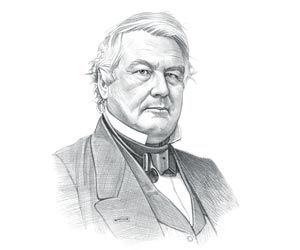|
The major accomplishments and the
famous, main events that occurred during the time that
Millard Fillmore was president included the publication
of Uncle Tom's Cabin by Harriet Beecher Stowe, the
Compromise of 1850, the 1850
Fugitive Slave Bill and Commodore Perry's
Mission to Japan (1852-54) and the Treaty of Kanagawa. Millard Fillmore
died of a stroke on March 8, 1874, aged 74. The next president was
Franklin
Pierce.
Birthday:
January 7, 1800
Place of Birth:
New York
Political Party:
Whig
Nickname:
American Louis Philippe
Number: 13th
President
Vice President:
No Vice President
Age at Inauguration:
50
Height: 5 feet
9 inches
Weight: 174
pounds
First Lady:
Abigail Fillmore
Religion:
Unitarian
Date of Death:
March 8, 1874
Date of Millard
Fillmore
Presidency:
July 9, 1850 to March 4, 1853
The Nickname of Millard Fillmore: The "American Louis Philippe"
The nickname of President Millard Fillmore provides an insight into how the man
was viewed by the American public during his presidency. The meaning
of the nickname the "American Louis Philippe" refers to the elegant
clothes worn by Louis Philippe, King of France (1830 - 1848). The
disparaging nickname "Wool Carder" referred to one of his earlier
jobs in a wool factory.
Character and Personality Type of Millard Fillmore
The character traits of President Millard Fillmore can be described
as genial, practical and logical. It has been speculated that the Myers-Briggs
personality type for Millard Fillmore is an ISFP (Introversion, Sensing,
Feeling, Perception). A quiet, easygoing character with a a "live
and let live" approach to life. A perfectionist, loyal to values and
beliefs. Millard Fillmore Personality type: Practical, action-oriented and
considerate.
Accomplishments of Millard Fillmore and the Famous Events during his Presidency
The accomplishments of Millard Fillmore and the most famous events during his
presidency are provided
in an interesting, short summary format
detailed below.
The Compromise of 1850
Summary of the Compromise of 1850: The
Compromise of 1850
was attempt to smooth out differences between the slave
states and the free states regarding the status of territories
acquired during the Mexican-American War (1846-1848). The Compromise
of 1850 allowed California to be admitted as a free state and the
New Mexico Territory and Utah Territory with slavery was left to
to the decision of the people in relation to
Popular
Sovereignty on Slavery, that asserted rule by
the people.
Fugitive Slave Act 1850
Summary of the Fugitive Slave Act 1850: The
Fugitive Slave Act 1850
was enacted during the presidency of Millard Fillmore. The law
was passed on September 18, 1850, as part of the
Compromise of 1850
and as a concession to the Southern states, increasing penalties
against fugitive slaves and the people who aided them.
Commodore Matthew Perry's Mission to
Japan
Summary of Commodore Matthew Perry's Mission to Japan:
Commodore
Matthew Perry's
Mission to Japan
used "Gunboat Diplomacy"
to open diplomatic and trade relations between the United
States and Japan. President Fillmore initiated the mission to Japan
by because the annexation of California had created an American port
on the Pacific enabling easier access to Asia. The development of
steam powered ships allowed faster access to distant ports making
the lucrative trade with Japan more viable.
The Treaty of Kanagawa
Summary of the Treaty of Kanagawa: The
Treaty of Kanagawa
was signed on March 31, 1854 by Commodore Matthew Perry and
Shogunate representatives of the Japanese government
signaling the end
of Japanese isolation.
Uncle Tom's Cabin by Harriet Beecher
Stowe
The famous anti-slavery
book,
Uncle Tom's Cabin by
Harriet Beecher Stowe
was published in 1852 during the presidency of Millard Fillmore. The
characters featured in Uncle Tom's Cabin personalized the political
and economic arguments about slavery and convinced the people of the
North that bounds had be set to the extension of slavery. |

